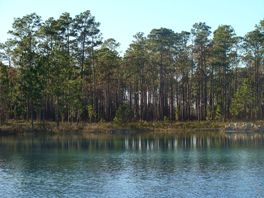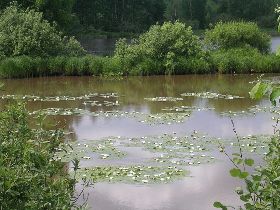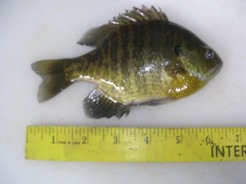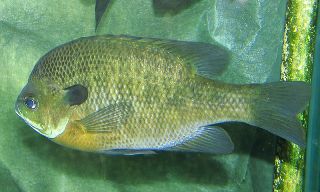Navigation
Date With Me....Mate With Me: A Courting Story
The Role of a Male Bluegill in Reproduction
 Male bluegills play an extraordinary role in the reproduction process! As soon as the water nears 67 degrees Fahrenheit, males gather in shallow water
(Holtan, 1990). The nesting spots are usually free of
vegetation, which makes males vulnerable to predation.
It must be noted that these colonies are not always seen in other
related fish species. The exact population of a colony
varies. In general, about 50 males gather at each spawning site
(Spotte, 2007). Using their tails,
the males make a small nest for females to lay their eggs.
Male bluegills play an extraordinary role in the reproduction process! As soon as the water nears 67 degrees Fahrenheit, males gather in shallow water
(Holtan, 1990). The nesting spots are usually free of
vegetation, which makes males vulnerable to predation.
It must be noted that these colonies are not always seen in other
related fish species. The exact population of a colony
varies. In general, about 50 males gather at each spawning site
(Spotte, 2007). Using their tails,
the males make a small nest for females to lay their eggs.
A Female Bluegill Searching for a Mate
 Females eventually move into the spawning beds. They are picky,
however! As a natural defense mechanism from predation, they lay
their eggs in the center of the nesting site. Once towards the
middle, females scan the area for potential mates. They choose
males with larger bodies and ears. Thus, large ear size is a
desirable trait for males to have. Once a female finds a suitable
male, the courtship process begins.
Females eventually move into the spawning beds. They are picky,
however! As a natural defense mechanism from predation, they lay
their eggs in the center of the nesting site. Once towards the
middle, females scan the area for potential mates. They choose
males with larger bodies and ears. Thus, large ear size is a
desirable trait for males to have. Once a female finds a suitable
male, the courtship process begins.
The Courtship Process in Bluegills
As a female approaches, the male begins quickly circling his nest.
Soon after, the male acts aggressively towards the possible mate.
The female either stays or finds a more suitable partner. The
fertilization process is completely external. Females touch
bellies with males; meanwhile, eggs and sperm are released and fall into
the nest. A female caught in the Mississippi had 12,000 eggs!
(Spotte, 2007). As soon as females release
all of their eggs, they leave the nesting site. In contrast, males
stay to defend their nests. Many intruders attempt to consume the
eggs; however, aggressive activity allows the males to fend off
predators. After about ten days, these precious eggs hatch
(Spotte, 2007). The male stays for a
couple more days until the recently hatched bluegills, known as fry,
swim to more vegetated areas. Here, the fry find possible
food items. They feed constantly in hopes of
reaching reproductive maturity.
or finds a more suitable partner. The
fertilization process is completely external. Females touch
bellies with males; meanwhile, eggs and sperm are released and fall into
the nest. A female caught in the Mississippi had 12,000 eggs!
(Spotte, 2007). As soon as females release
all of their eggs, they leave the nesting site. In contrast, males
stay to defend their nests. Many intruders attempt to consume the
eggs; however, aggressive activity allows the males to fend off
predators. After about ten days, these precious eggs hatch
(Spotte, 2007). The male stays for a
couple more days until the recently hatched bluegills, known as fry,
swim to more vegetated areas. Here, the fry find possible
food items. They feed constantly in hopes of
reaching reproductive maturity.
To learn more about the courtship process click
here!
A Bluegill Reaching Reproductive Maturity
Food resources, predation pressures, and competition all play roles
in the rate at which bluegills
 reach reproductive maturity. In
Wisconsin, a bluegill may not engage in reproduction until their fourth
spring. In contrast, bluegills in Florida may reach maturity at
one year of age (Spotte, 2007). This
difference is due to increased foraging in warmer waters.
Regardless of geographic location, bluegills travel to nesting sights
during the spring they reach maturity. On average, adults weigh 6
to 8 ounces and reach 9 to 12 inches in length
(Holton, 1990).
reach reproductive maturity. In
Wisconsin, a bluegill may not engage in reproduction until their fourth
spring. In contrast, bluegills in Florida may reach maturity at
one year of age (Spotte, 2007). This
difference is due to increased foraging in warmer waters.
Regardless of geographic location, bluegills travel to nesting sights
during the spring they reach maturity. On average, adults weigh 6
to 8 ounces and reach 9 to 12 inches in length
(Holton, 1990).
| Mature Mississippi Bluegill (Image taken by Author) |
